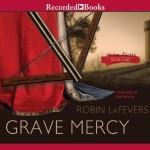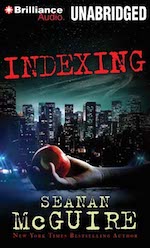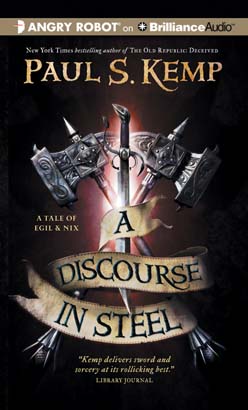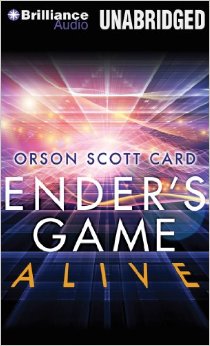
 Grave Mercy
Grave Mercy
by Robin LaFevers; Read by Erin Moon
Publisher: Recorded Books
Publication Date: 3 April 2012
[UNABRIDGED] – 14 hours 14 minutes
Themes: / historical fiction / assassins / medieval / politics / young adult
Ismae, our protagonist, is a teenage nun assassin in fifteenth-century Brittany. That descriptor alone, issued by a guest on NPR’s Pop Culture Happy Hour podcast, was enough to hook my attention and reel me into listening to this book. The term “nun assassin” alone, evoking a strong sense of cognitive dissonance, is rife with narrative potential. Mix in some fantastic elements of ancient gods masquerading as saints and set the whole thing against a late medieval backdrop, and you would seem to have all the ingredients for an entertaining, emotional, and perhaps even thought-provoking novel. Unfortunately, Robin LaFevers’s young adult novel Grave Mercy falls short in almost every regard.
The novel opens with great promise. Ismae finds herself rescued inexplicably from an arranged marriage and whisked away to the convent of Saint Mortain, who, in LaFevers’s universe, is the ancient Britonic god of death who lives on in the guise of a Catholic saint. She quickly gains acceptance as one of Mortain’s servants and begins her training as an assassin. We meet several of her Sisters in training, who show immense promise as complex, complicated characters. Ismae immediately shows promise in the deadly arts, especially in the brewing of poisons. The stage is set for a Potteresque term of training, comeraderie, and schoolyard intrigue. I very much wanted to read that book.
Unfortunately, we are soon whisked three years into the future just as Ismae receives her first assignment as a full-fledged assassin. Easily dispatching her first victim, she then undertakes a much more difficult assignment at the behest of the Abbess. This task throws her smack-dab in the middle of Brittany’s courtly circle, where the young Duchess struggles to fend off both French invaders and equally persistent suitors. Under the pretense of serving as mistress to Duval, the Duchess’s bastard brother, Ismae must try to sort out the tangled web of politics and allegiances.
Wait, what? Where’s my Bildungsroman? I was looking forward to a classic coming-of-age story, but instead find myself listening to a book of court intrigue. There’s nothing inherently wrong with court intrigue, of course, except that most of the members of court in Grave Mercy are utterly forgettable, and those who do show a spark of personality don’t receive much stage time. There are no Lannisters or Starks here. Characters from the novel’s tantalizing early chapters hardly receive a second mention. The plot simply doesn’t hold together.
My second complaint is more subjective: the novel just isn’t rooted enough in fantasy. Mortain, the ancient god of death who marks his targets for the sisters of the convent, is potentially a fantastic character, or at least a useful construct, but sadly we learn about him and him only indirectly. Had we been treated to more time at the convent, we might have learned more of his mysterious ways. The novel also hints that other old gods also live in LaFevers’s Brittany, and presumably the remaining novels in the His Fair Assassin series shed more light on their nature. This volume, however, resembles historical fiction more than fantasy.
Despite its medieval setting, there isn’t much in the writing and themes that bear much resemblance to the writing or thought of the Middle Ages. The prose, while capable and at times even captivating, feels thoroughly modern in its tone and diction. The characters converse in a colloquial style that feels sterile and devoid of even the veneer of medieval cultures that most authors apply when setting stories in this time period. Ismae is an empowered young woman of the 21st-century variety, and the undertones of trauma and survival also have a modern ring to them. LaFevers is writing for a young adult audience, which in theory should make these choices easier to swallow. I grew up reading authors like Tolkien and Kipling and even Shakespeare, though, so I don’t buy into the assumption that fiction should be diluted for young readers. I’m not saying that this was necessarily LaFevers’s explicit intension, but rather that the current YA culture subconsciously encourages these trends. The genre’s very existence, to some extent, proves my point.
Erin Moon’s mellifluous narration makes Grave Mercy a pleasant listening experience even if the story itself is uneven. She captures Ismae’s quavering sense of vulnerability, and gives distinct voices to the other characters, at least to the extent the writing allows. Her pronunciation of French place-names, with one or two minor exceptions, is pretty much spot-on. Nothing ruins an otherwise-perfect audiobook like even a few pesky mispronunciations. So even though I wasn’t always captivated by the story, Moon’s performance kept me listening to the end.
As I look back, I’ve tried reading several assassin-themed fantasy novels: Robin Hobb’s Assassin’s Apprentice, Brent Weeks’s The Way of Shadows, and Maria V. Snyder’s Poison Study. This is the first one I’ve actually finished. Assassins should make for compelling, dynamic characters spinning taut webs of dramatic tension. But for some reason they have always fallen short in this reader’s estimation. Maybe my subconscious finds them somehow inherently distasteful, or maybe the kinds of stories they find themselves in just aren’t to my liking. Take that into consideration in my review. If you like assassin stories, you’ll probably find much to enjoy about Grave Mercy.
Posted by Seth Wilson




